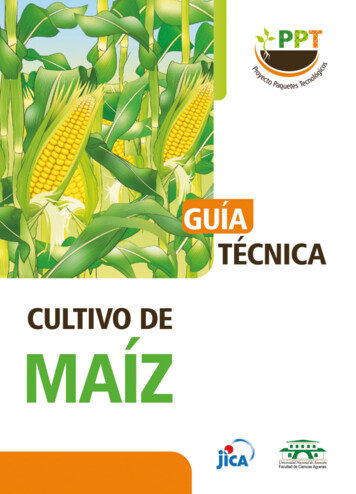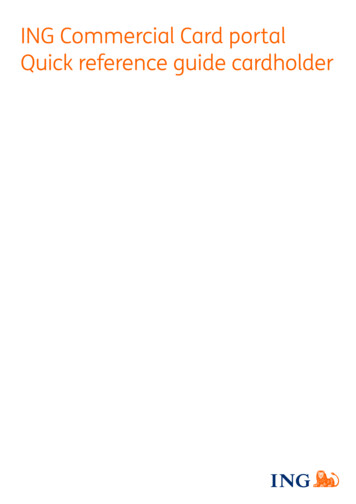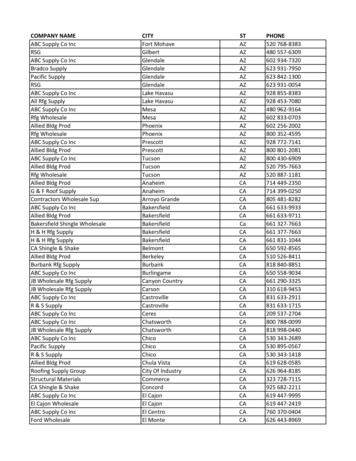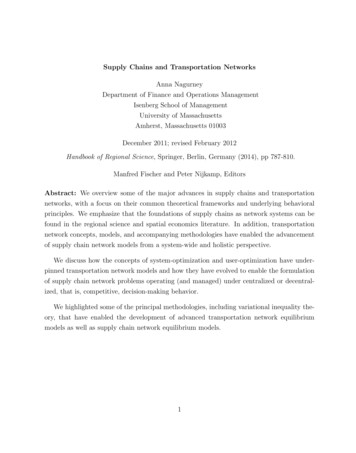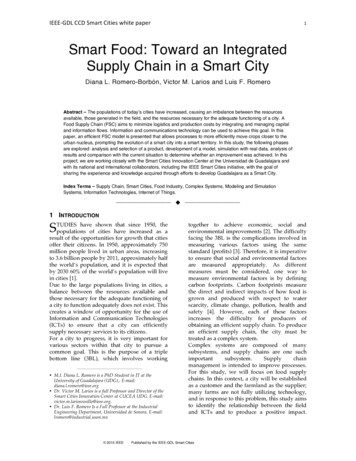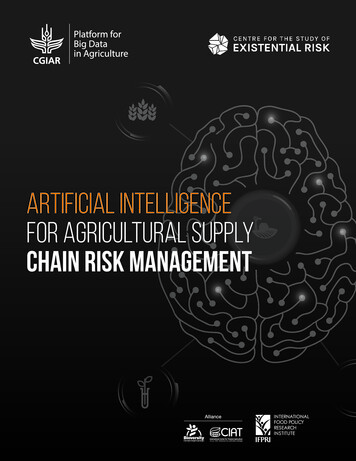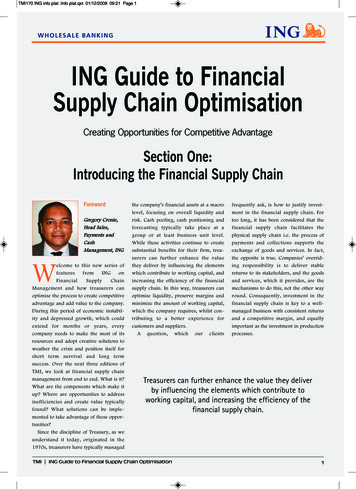
Transcription
TMI170 ING info plat :Info plat.qxt 01/12/2008 09:21 Page 1ING Guide to FinancialSupply Chain OptimisationCreating Opportunities for Competitive AdvantageSection One:Introducing the Financial Supply ChainForewordGregory Cronie,Head Sales,Payments andCashManagement, INGWelcome to this new series offeaturesfromINGonFinancialSupplyChainManagement and how treasurers canoptimise the process to create competitiveadvantage and add value to the company.During this period of economic instability and depressed growth, which couldextend for months or years, everycompany needs to make the most of itsresources and adopt creative solutions toweather the crisis and position itself forshort term survival and long termsuccess. Over the next three editions ofTMI, we look at financial supply chainmanagement from end to end. What is it?What are the components which make itup? Where are opportunities to addressinefficiencies and create value typicallyfound? What solutions can be implemented to take advantage of these opportunities?Since the discipline of Treasury, as weunderstand it today, originated in the1970s, treasurers have typically managedTMI the company’s financial assets at a macrolevel, focusing on overall liquidity andrisk. Cash pooling, cash positioning andforecasting typically take place at agroup or at least business unit level.While these activities continue to createsubstantial benefits for their firm, treasurers can further enhance the valuethey deliver by influencing the elementswhich contribute to working capital, andincreasing the efficiency of the financialsupply chain. In this way, treasurers canoptimise liquidity, preserve margins andminimize the amount of working capital,which the company requires, whilst contributing to a better experience forcustomers and suppliers.A question, which our clientsfrequently ask, is how to justify investment in the financial supply chain. Fortoo long, it has been considered that thefinancial supply chain facilitates thephysical supply chain i.e. the process ofpayments and collections supports theexchange of goods and services. In fact,the opposite is true. Companies’ overriding responsibility is to deliver stablereturns to its stakeholders, and the goodsand services, which it provides, are themechanisms to do this, not the other wayround. Consequently, investment in thefinancial supply chain is key to a wellmanaged business with consistent returnsand a competitive margin, and equallyimportant as the investment in productionprocesses.Treasurers can further enhance the value they deliverby influencing the elements which contribute toworking capital, and increasing the efficiency of thefinancial supply chain.ING Guide to Financial Supply Chain Optimisation1
TMI170 ING info plat :Info plat.qxt 01/12/2008 09:21 Page 2Fig 1: Example Physical Supply ChainING has investedheavily in developingits internationalscope and solutions tobecome a leadingbank in many of thedisciplines whichcomprise effectivefinancial supply chainmanagement, fromtrade services andtrade finance, throughto cash andliquidity management.Source: Asymmetric Solutions LtdTo enable companies to leverageopportunities for improvement in thefinancial supply chain, ING has investedheavily in developing its internationalscope and solutions to become a leadingbank in many of the disciplines whichcomprise effective financial supply chainmanagement, from trade services andtrade finance, through to cash andliquidity management. In this series, welook at each step in the financial supplychain, from explaining the basics toaddressing the complexities of globalsupply chains.This innovative ING Guide will bepresented in three parts. In this first part,ING introduces the financial supply chainand outlines the order-to-cash andpurchase-to-pay processes. In the secondpart, which will appear in the nextedition of TMI, we look at supply chainfinancing alternatives and how these canbe used to unlock working capital. In thefinal part, we look at financial supplychain optimisation from a strategic perspective, including some of the industryinitiatives of which corporate treasurers2can take advantage to maximise liquidityand reduce costs.What is theFinancial Supply Chain?Physical Supply ChainFinancial supply chain management is anexpression which has become de rigeurbut the concept is by no means new. Thefinancial supply chain is a parallel, butopposite process to the physical supplychain, which is the supply and demand ofgoods and services. Company A whichsupplies goods will collect money inreturn, Company B which requires thegoods will pay money in return.Every company’s supply chain isdifferent, from the rudimentary to thehighly complex, not least according toindustry, business model, diversification,degree of centralisation, sourcing andconsumer markets. Over the past 50 years,international trade has doubled every fiveyears - an increase of 1,000% over thisperiod. Furthermore, the physical supplychain has become substantially moreTMI complex in terms of the volumes involvedand the number of participants to a transaction. The increase in volumes is not onlydue to the overall growth in trade but theaverage size of transactions has reduced toaround 42% of transaction value inrelative terms since the 1970’s. Moretransactions, more customers, moresuppliers and more participants in thechain.Information Supply ChainTo respond to these changes and maintaina competitive position, companies havemade substantial progress in automatingthe physical supply chain, with highlysophisticated sourcing, production anddistribution. ‘Just in time’ (JIT) production, originally a Japanese phenomenon,is common in many firms as a way ofreducing cash tied up in surplus stock.Companies in all industries, both goodsand services, invest a great deal of timeand resource in forecasting demand toensure appropriate levels of supply. Tofacilitate this process, a parallel strand tothe physical supply chain has developed -ING Guide to Financial Supply Chain Optimisation
nTMI170 ING info plat :Info plat.qxt 01/12/2008 09:21 Page 3the information supply chain - to ensureeffective communication between eachstage of production and distribution, particularly through the use of enterpriseresource planning (ERP) tools.Fig 2: Sample Financial Supply ChainFinancial Supply ChainPeople often associate the physical supplychain with a “one way” flow of goodsand services i.e. those that the companyproduces. In reality, this only tells halfthe story, as companies will be sourcinggoods and services as well as producingthem. This is a crucial distinction when itcomes to understanding the financialsupply chain and its relationship betweenworking capital and liquidity management. In many respects, it is useful tothink of the financial supply chain asbeing a parallel, but reverse process tothe physical supply chain. As goods andservices pass through the chain from production to customer, cash flows fromcustomer to the company. Similarly, as acompany imports or demands goods andservices, cash passes from the company toits suppliers.The process illustrated in fig 2,although a simplified version, is replicated on the left of the diagram for everyorder from every supplier (purchase-topay) and similarly for every order givento every customer on the right (order-ofcash). We will come back to each of thesetwo sets of processes, and the relationshipbetween them, which creates thecompany’s working capital requirement.It will already be obvious, however, of theneed to ensure efficiency in the financialSource: Asymmetric Solutions Ltdsupply chain, not least to ensure thatvarious elements of the process, such aspurchase order, invoice and payment canbe integrated and reconciled easily.Furthermore,giventhemultipleexchanges of information betweensupplier and Company A, and Company Aand customer, the more effective thiscommunication process, and the moreconsistent the information used by eachparty, the better the process will be. Thisbecomes even more significant whenthere are queries or late payments. Inmany ways, developments in the financialsupply chain have lagged behind those ofthe physical supply chain. As we will seelater in this series, while companies have“Trade finance is an area in which companies can deliversignificant working capital improvements by reducing thetime from order to payment. Firstly, ensuring the accuracy oftrade documentation is critical. Working with a strong tradefinance bank which has a deep knowledge of the regulations,conventions and tariffs in the countries in which you operateis also an essential way of ensuring that the order-to-cashprocess is as efficient and timely as possible.”Luc Hopmans, Senior Consultant Trade Finance Services, INGTMI ING Guide to Financial Supply Chain Optimisationmade significant progress in automatingevents in the financial supply chainwithin their own organization, there isstill a great deal of potential to connectthe parties in the chain, including thebanks, more closely.ConductingInternational TradeThe use of cash to pay for these goodsand services i.e. payment and collection,was probably first introduced in China inaround 2700 BC. The bank notes withwhich we are familiar originated in theBank of England in the late seventeenthcentury, and cheques were also firstissued by the Bank at around the sametime, becoming a popular method offacilitating trade by the late eighteenthcentury.However, the use of cash or cashequivalent instruments alone was notsufficient for many exporters andimporters. In particular, difficultiesarose when there was a difference in thecredit standing of the seller andpurchaser, especially when conducting3
TMI170 ING info plat :Info plat.qxt 01/12/2008 09:21 Page 4trade cross-border. A stronger sellerwould be concerned that a weakerpurchaser, particularly overseas, coulddefault on payment. To reduce this risk,the seller might demand upfrontpayment. On the other hand, thepurchaser would be concerned aboutadvance payment without the opportunity to assess the goods first. This hashad a variety of consequences, not leasta wide spectrum of different paymentterms which a company may require, orbe obliged to adhere to, creating difficulties in the payments process whenlarge volumes of payments are involved.Another result is that banks developedan intermediary role to help exporters andimporters manage their respective risks.The trade instruments with which we arefamiliar today, such as letters of credit andother documentary credits, were firstcommonly used in the late nineteenthcentury. A letter of credit, or LC, is aguarantee issued by the buyer’s bank tothe seller which guarantees payment onpresentation of the correct trade documentation (fig 3). The bank mitigates its ownrisk by taking ownership of the goods untilit has received payment by the buyer, butas banks cannot physically take delivery ofgoods, the trade documentation whichrelates to legal title to the goods is usedinstead.The process from stage 1 to stage 13can frequently take many weeks,hindering companies’ efforts to restrictFig 3: Letter of Credit ProcessSource: Asymmetric Solutions Ltdthe amount of stock tied up and delayingpayment. This is often due to inaccuraciesin the trade documentation which thenneeds to be corrected and resubmitted frequently more than once - prolongingan already lengthy process. Consequently,increasing the efficiency of tradeprocesses as far as possible is animportant priority for companies’ financedepartments to avoid interrupting thephysical supply chain and ensuringearlier payment. This applies too to thebuyers who use letters of credit. While itmay appear that buyers would prefer toDuring the current economic recession, companies aremore focused on customer payment risk and thereforeletters of credit are likely to be more important thanduring more favourable economic conditions.4TMI pay later, the delay in gaining legal titleto the goods can impact substantially onthe firm’s business and the paymenttiming becomes unpredictable, requiringlarge amounts of working capital to beheld pending payment.Trade & CashOver recent years, there has been a substantial growth in ‘open account’ i.e.transactions paid directly rather thanusing trade instruments such as letters ofcredit. However, although open accountnow represents the majority of transactions, the growth of international tradeover the past half-decade which wereferred to earlier means that tradeservices are still increasing. Furthermore,although transactions conducted underopen account are increasing, the risks ofunequal trading partners, particularlyinternationally, still remain. During thecurrent economic recession, companiesare more focused on customer paymentrisk and therefore letters of credit arelikely to be more important than duringmore favourable economic conditions.ING Guide to Financial Supply Chain Optimisation
nTMI170 ING info plat :Info plat.qxt 01/12/2008 09:21 Page 5The letter of credit process is a form offinancing for sellers, the beginnings of animportant trend in the services whichbanks are increasingly offering, namelyusing different elements of the financialsupply chain, such as receivables,invoices or even purchase orders as collateral for financing. In credit-strappedtimes, this type of financing is becomingincreasingly important to treasurers, aswe will discuss further in the next editionof TMI. These innovations include mechanisms such as supplier financing whichuses a customer’s higher credit rating asa means of securing financing for lowerrated suppliers.Working CapitalManagement vs WorkingCapital OptimizationFundamental to treasurers’ role is maintaining liquidity to ensure that thecompany has sufficient levels of workingcapital to finance its regular activities.Working capital is the amount of cashwhich a company requires to fund thedifference (both in amounts and timing)between payment and collection.There are a range of risks and scope fordelay in both the order-to-cash andpurchase-to-pay processes. The effect ofthis is to postpone collection of cash andmake both payment and collection timingunpredictable. This means that even if thepayment and collection amounts eachmonth are similar, the company needs tomaintain a “float” or working capitalamount to finance cash flow volatility andtiming mismatches. A frequent metric usedfor calculating working capital requirements is ‘cash days’. This is calculated byadding the number of days sales outstanding (DSO) to the number of days inventoryoutstanding (DIO) and subtracting dayspayables outstanding (DPO).i.e. (DSO DIO) - DPO Cash DaysTMI “The relationship between trade and cash is important for treasurers and there isa significant risk that companies’ ability to forecast cash flow and manageworking capital effectively will be hindered if these are treated independently.Trade finance has typically fallen outside most treasurers’ remit, except to takeinto account of the resulting financial flows into the cash position or cash flowforecast. The transaction size involved is often huge, so every day’s paymentdelay can have a substantial impact on liquidity and the amount of workingcapital which needs to be held. Consequently, there is a huge incentive for treasurers of exporters or importers to become more involved in this area. As well astaking responsibility for liquidity management, treasurers maintain banking relationships on behalf of the company. By representing both the cash and tradefinance needs of the company, which are intimately connected in the drivetowards improved working capital as we shall see, treasurers can leverage theserelationships and structure solutions based on the overall needs of the company.”To help companies use the financial supply chain, including both trade andcash, more strategically to manage working capital and liquidity, banks such asING are taking an increasingly integrated approach to providing advisoryservices and solutions in financial supply chain management, including bothtrade and cash elements.Robert Dekker, Global Head of Sales Corporate & Institutional Clients,Payments and Cash Management, INGFor example, if DSO 45 days, DIO is25 days and DPO is 20 days, the totalnumber of cash days is 50 days (45 25- 20 days). Therefore, if Company A’ssales are 1bn a year, daily sales average 4m. The cash required to run thebusiness is the daily sales figure multiplied by the number of cash days 200m. For Company A, the workingcapital requirement represents 20% ofannual revenue which cannot be usedfor strategic investment or otherbusinesspurposeswhichcouldotherwise contribute to its competitiveposition. Consequently, in this example,for every day’s reduction in the numberof cash days, the working capitalrequirement can be reduced by 4m, animmediate contribution to the bottomline. Working capital levels differbetween industries but there are fewcompanies which have delivered themaximum possible efficiency in thisarea.Many treasurers have alreadyachieved significant treasury centralisation, and automation and efficiency inING Guide to Financial Supply Chain Optimisationtreasury operations, the skills which arealso required to develop efficiency in thebusiness functions which contribute tothe number of cash days, particularlyorder-to-cash and purchase-to-pay.Focusing on one of these areas alone willdeliver some benefit but less than acohesive working capital optimisationinitiative with a closer connection established between the two sets of processes,with the results apparent in treasurythrough greater liquidity and lowerworking capital requirements.In some cases, treasurers are takingan advisory role in these areas; in others,payment and/or collection factories arefalling under treasurers’ remit. In thisway, treasurers have a greater abilitynot only to manage liquidity and ensurethat the required level of workingcapital is available, but to minimize theactual amount of working capital whichis necessary. This has a direct value tothe business and therefore is animportant way in which treasurers canelevate their influence and profilewithin the company. n5
scope and solutions to become a leading bank in many of the disciplines which comprise effective financial supply chain management, from trade services and trade finance, through to cash and liquidity management. Source:Asymmetric Solutions Ltd TMI170 ING info plat :Info plat.qxt 01/12/2008 09:21 Page 2.


